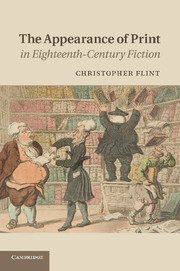Book contents
- Frontmatter
- Contents
- Figures
- Acknowledgments
- Introduction: Prose Fiction and Print Culture in Eighteenth-Century Britain
- Part One Author book reader
- Part Two Reader book author
- Chapter 3 Dark matters: printer’s ornaments and the substitution of text
- Chapter 4 Inanimate fiction: circulating stories in object narratives
- Chapter 5 Only a female pen: women writers and fictions of the page
- Chapter 6 After words
- Notes
- Bibliography
- Index
Chapter 3 - Dark matters: printer’s ornaments and the substitution of text
from Part Two - Reader book author
Published online by Cambridge University Press: 07 September 2011
- Frontmatter
- Contents
- Figures
- Acknowledgments
- Introduction: Prose Fiction and Print Culture in Eighteenth-Century Britain
- Part One Author book reader
- Part Two Reader book author
- Chapter 3 Dark matters: printer’s ornaments and the substitution of text
- Chapter 4 Inanimate fiction: circulating stories in object narratives
- Chapter 5 Only a female pen: women writers and fictions of the page
- Chapter 6 After words
- Notes
- Bibliography
- Index
Summary
… it was print, not writing, that effectively reified the word.
(Walter Ong, Orality and Literacy, 1982)Introduction
**** *** *** ******
(Laurence Sterne, Tristram Shandy, 1762)In the post-Shandean period of eighteenth-century British fiction, books commonly joked about the disappearance of the author, though the jokes themselves frequently made the author a visible function of the text, as the frontispiece of “Somebody” in Bartholomew Sapskull comically suggests. Sterne himself notoriously merged the characters Tristram Shandy and Yorick with his own, as if he did not know which was more imaginary. Tristram Shandy similarly blurs its own identity as a book, not only interleaving Sterne’s fiction and his non-fiction (particularly Yorick’s Sermons) but also borrowing text liberally from prior writers, and mixing visual elements such as the black, marbled, and white pages, with verbal ones. Various invitations to the reader to construct the text, as when Tristram offers the reader a blank page to draw the Widow Wadman or dashes off a group of asterisks to be decoded, further make the writer seem part of a collaborative process by which authors, printers, publishers, and consumers constitute “reading matter.” Social and legal pressures often necessitated such deliberate authorial masking, but Sterne (and many other eighteenth-century writers) also used techniques of disavowal to prompt readers to reflect on their own interpretive efforts.
- Type
- Chapter
- Information
- The Appearance of Print in Eighteenth-Century Fiction , pp. 105 - 153Publisher: Cambridge University PressPrint publication year: 2011

